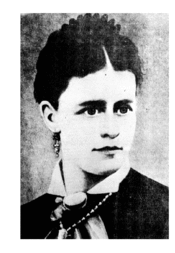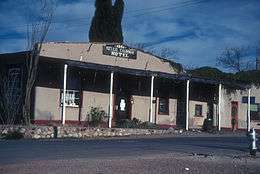Nellie Cashman
Ellen "Nellie" Cashman (1845 – January 4, 1925), better known as Nellie Cashman, became noted across the American West and in western Canada as a nurse, restaurateur, businesswoman, Roman Catholic philanthropist in Arizona, and gold prospector in Alaska.[1] A native of County Cork, Ireland, she and her sister were brought as young children to the United States by their mother about 1850 to escape the poverty of the Great Famine. The family lived first in Boston, Massachusetts, where the girls also worked until old enough, before migrating to San Francisco, California, in 1865.
Nellie Cashman | |
|---|---|
 Ellen Cashman | |
| Born | Ellen Cashman 1845 Midleton, County Cork, Ireland |
| Died | 4 January 1925 (aged 79) |
| Occupation | Nurse, restaurateur, entrepreneur, and gold prospector |
| Spouse(s) | Never married |
| Children | Reared five nieces and nephews |
Cashman established her first boarding house for miners in Pioche, Nevada.[1] She then set up a boarding house serving miners of the Cassiar gold mine in British Columbia. When she returned to Victoria, British Columbia, upon hearing of miners starving back in the Cassiar Mountains, she led a rescue party back to the gold mine, earning her the nickname "Angel of the Cassiar".
After moving to Tombstone, Arizona, c. 1880, Cashman raised money to build the Sacred Heart Catholic Church, and did charitable work with the Sisters of St. Joseph.[1] She successfully reared the five children of her sister Fanny after they were orphaned in 1883. In the late 1880s, Cashman set up several restaurants and boardinghouses in Arizona.
In 1898 she went to the Yukon during the Klondike Gold Rush for gold prospecting, working there until 1905.[1] She became nationally known as a frontierswoman, with the Associated Press covering a later trip. In 2006 Cashman was inducted into the Alaska Mining Hall of Fame.
Early years
Ellen "Nellie" Cashman was born in Midleton, County Cork in mid 1840s. Some sources give 1844 as her year of birth, while some other research indicates she was the Ellen Cashman baptised on 15 October 1845.[2][3] Her family lived on Free School Lane (now known as Mc Donaghs Lane). Cashman was brought to the United States around 1850 by her mother, along with her sister Frances (known as Fanny); they settled first in Boston. It is possible the family emigrated due to the Irish Famine. As an adolescent, Cashman worked as a bellhop in a Boston hotel. In 1865 she and her family migrated to San Francisco, California.[2][4]
British Columbia
Cashman left her family home in 1874 for the Cassiar Country in British Columbia, Canada. A lifelong Catholic, she set up a boarding house for miners at Telegraph Creek, asking for donations to the Sisters of St Anne in return for the services available at her boarding house.[1] Cashman was travelling to Victoria to deliver 500 dollars to the sisters of St. Anne when she heard that a snowstorm had descended on the Cassiar Mountains, stranding and injuring 26 miners, who were also suffering from scurvy. She took charge of a six-man search party and collected food and medicine to take to the stranded miners. Conditions in the Cassiar Mountains were so dangerous that the Canadian Army advised against attempting the rescue. Upon learning of Cashman's expedition, a commander sent his troops to locate her party and bring them to safety. An army trooper eventually found Cashman camped on the frozen surface of the Stikine River. Over tea, she convinced the trooper and his men that it was her will to continue, and that she would not head back without rescuing the miners. After 77 days of harsh weather, Cashman and her party located the sick men, who numbered far more than 26. Some historical accounts credit Cashman with saving the lives of as many as 75 men. She administered a diet containing Vitamin C to restore the men to health. She was afterward fondly known in the region as the "Angel of the Cassiar".[4]
Arizona

About 1880, Cashman moved to Tombstone, Arizona. She raised money to build the Sacred Heart Catholic Church, and committed herself to charity work with the Sisters of St. Joseph. She took a position as a nurse in a Cochise County hospital but also opened another restaurant and boarding house.
Her sister Fanny Cunningham was widowed in 1881. Cashman arranged for Fanny and her five children to move to nearby Tucson, Arizona. Fanny died in 1884 of tuberculosis, leaving her children in Cashman's care.[3]
Soon after her sister's death in 1884, Cashman travelled to Baja California after hearing rumours of untapped gold and silver deposits. She joined 21 men in a short-lived prospecting venture. Sixteen hours into the 100-mile journey, in conditions of extreme heat and drought, the group had already nearly depleted their water supplies, and most of the men were suffering from dehydration. They abandoned their venture.
In December 1883, bandits committed the Bisbee Massacre in Tombstone, killing four innocent bystanders and wounding two others in the course of a robbery. The five men were convicted and sentenced to die by hanging on 28 March 1884. Many people were eager to make a spectacle of the execution. A local carpenter built a grandstand next to the hanging site, planning to charge for tickets. Cashman was outraged, feeling that no execution should be celebrated. She befriended the five convicts, visiting them to provide spiritual guidance. Cashman convinced the sheriff to set a curfew on the day of the hangings to prevent a crowd from forming. The night before the execution, Cashman and a crew of volunteers tore down the grandstand. The hangings proceeded as scheduled, but out of public view. When Cashman learned that a medical school planned to exhume the bodies of the convicts for study, she enlisted two prospectors to stand watch over the Boot Hill Cemetery for 10 days.
Cashman and her associate Joseph Pascholy co-owned and ran a restaurant and hotel in Tombstone called Russ House, now known as Nellie Cashman's. According to a popular legend, a client once complained about Cashman's cooking. Fellow diner Doc Holliday drew his pistol, asking the customer to repeat what he had said. The man said, "Best I ever ate."
In 1886, Cashman left Tombstone to travel across Arizona, opening restaurants and boarding houses in Nogales, Jerome, Prescott, Yuma, and Harquahala, near Phoenix.
Yukon and Alaska
In 1898, Cashman left Arizona for the Yukon in search of gold, staying until 1905. Her prospecting ventures took her to Klondike, Fairbanks, and Nolan Creek. She later owned a store in Dawson City.[1] She settled in Koyukuk, along with other established miners.
In 1921, Cashman visited California, where she declared her desire to be appointed US deputy Marshal for the area of Koyukuk. In 1922, the Associated Press documented her lengthy trip from Nolan Creek to Anchorage.
In January 1925, Cashman developed pneumonia and rheumatism. Friends admitted her to the Sisters of St. Anne, the same hospital which she had helped to build fifty-one years earlier. She died there, and was interred at Ross Bay Cemetery in Victoria, British Columbia.[5]
Legacy and honors
- The 1959–1960 season of the ABC western television series, The Life and Legend of Wyatt Earp, with Hugh O'Brian starring as Wyatt Earp, featured a fictional character based on Nellie Cashman played by actress Randy Stuart.
- Grace Lee Whitney played Cashman in "The Angel of Tombstone" of the syndicated western series Death Valley Days, hosted by Robert Taylor a few months before his own death in 1969. In the story line, Cashman and several men from Tombstone travel to Baja California in search of gold found by a Mexican prospector. On reaching the site, Cashman learns how a prosperous Catholic mission has been quietly financing its charitable work. Gregg Barton, Tris Coffin, and Joaquin Martinez also guest starred in this episode.[6]
- On October 18, 1994, Cashman was featured on a United States postage stamp as part of the Legends of the West series.
- On March 15, 2006, Nellie Cashman was inducted posthumously into the Alaska Mining Hall of Fame.[7]
- In 2007, she was inducted into the National Cowgirl Museum and Hall of Fame in Fort Worth, Texas.
- In June 2014, a monument in Nellie's honour was erected near her home in Midleton Co. Cork.[8]
References
- "Biography – CASHMAN, ELLEN (also known as Nellie Pioche and Irish Nellie) – Volume XV (1921-1930)". Dictionary of Canadian Biography. Retrieved 13 November 2018.
- "A miner with a heart of gold – An Irishman's Diary about the extraordinary Nellie Cashman". The Irish Times. Retrieved 13 November 2018.
- White, Lawrence William (2009). "Cashman, Nellie". Dictionary of Irish Biography - Cambridge University Press. Retrieved 9 April 2020.
- "Nellie Cashman – Pioneering the Mining Camps – Legends of America". www.legendsofamerica.com. Retrieved 13 November 2018.
- Judy Barrett Litoff (1994). European Immigrant Women in the United States: A Biographical Dictionary. Taylor & Francis. p. 52. ISBN 978-0-8240-5306-2.
- "The Angel of Tombstone on Death Valley Days". Internet Movie Data Base. Retrieved 14 July 2015.
- "Ellen (Nellie) Cashman (1845–1925)", Alaska Mining Hall of Fame Foundation
- "CorkgoldminerNellie Cashman set for honour". 8 June 2015. Retrieved 13 November 2018.
Further reading
- Don Chaput, 1995, I'm Might Apt to Make a Million or Two: Nellie Cashman, and the North American Mining Frontier, Tucson, Westernlore Press.
- John P. Clum, 1931, "Nellie Cashman," Arizona Historical Review, v. iii, 9–34.
- Ronald Wayne Fischer, 2000, Nellie Cashman: Frontier Angel, Talei Publishers.
- Melanie J. Mayer, 1989, Klondike Women, Ohio University Press.
- Claire Rudolf Murphy and Jane G. Haigh, 1997, "Nellie Cashman," in Gold Rush Women, Alaska Northwest Books, p. 112-116.
- Anon. (1999). The Islander, Portraits of Cobh, (No.3), Cobh Museum, Co. Cork, 1999.
- Banks, Leo W. (1999). Stalwart Women: Frontier Stories of Indomitable Spirit. Arizona Highways Books. ISBN 978-0-916179-77-9.
- LeBlanc, Suzanne (2003). Cassiar: A Jewel in the Wilderness. Prince George, B.C. : Caitlin Press. ISBN 978-0-920576-99-1.
- Illing, Thora Kerr, 2016, Gold Rush Queen: the extraordinary life of Nellie Cashman, Canada, Touchwood Editions, ISBN 978-1-77151-159-9 }}.
External links
- Charles C. Hawley and Thomas K. Bundtzen (2006). "Ellen (Nellie) Cashman (1845–1925)", Alaska Mining Hall of Fame Foundation
- Charlene Porsild (2005). "Cashman, Ellen", Dictionary of Canadian Biography Online
- Nellie Cashman at Find a Grave
- Kathy Weiser (2017). "Nellie Cashman – Pioneering the Mining Camps", Legends of America